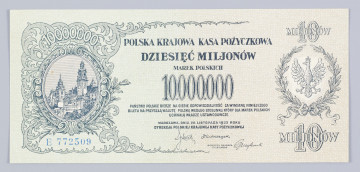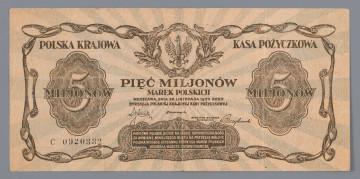
Cheque for 100,000,000 Polish marks - a template
1923
National Museum in Lublin
Part of the collection: Paper money during the Second Polish Republic
Economic difficulties of the Republic of Poland reborn in 1918 decided that the role of the central financial institution of the country was taken over by the Polish National Loan Bank (PKKP), which had been established by the German occupant in 1916, and the Polish mark (mkp) issued by it became the temporary Polish currency. PKKP and the Polish mark were not liquidated until 28 April 1924 with the opening of the Bank of Poland and the establishment of the zloty as the national currency.
In the first post-war years PKKP and mkp played a very important role in the process of economic and economic integration of the country, which was being united from the lands functioning under different systems of the partitioned states. The monetary unification of the Polish lands was crowned by the annulment of the ruble in the Borderlands in spring 1921, and of the German mark in Upper Silesia at the end of 1922.
A deepening budget deficit from 1919 onwards, associated with the state's financial needs and a lack of tax revenue in the face of a negative trade balance, led to the printing of successive tranches of mkp. The decline in the value of money is indirectly evidenced by the increasingly large denominations introduced into the market: in 1919 - 1,000 mkp, in 1920 and 1921 - 5,000 mkp. The banknote in question, 10 000 mkp, was introduced on 16 September 1922. At that time, it corresponded to the value of 166 single issues of "Kurier Warszawski". It was already a shadow of its former self. Especially if we consider that the value of 5,000 mkp on the day of its debut (26 February 1920) was equivalent to 10,000 issues of that daily newspaper. The rise in the price of the dollar from 156 mkp at the end of March 1920 to 8865 mkp in September/October 1922 also speaks of this. The dynamic inflation soon turned into hyperinflation, leading to the collapse of the mkp in late 1923.
The 10,000 mkp opens the inflationary series of banknotes printed in a new design in shades of brown and green, clearly distinguishable from the previous issues of 1919 and 1920, maintained in pastel colours and the decorativeness of Viennese Art Nouveau. These denominations are no longer luring in colours, and their graphic design, dominated by guilloche ornamentation, is not sophisticated. There are no national figures or heroes on them. Only the obverse of the 10 000 mkp features two heads of the same girl.
Tomasz Markiewicz
Author / creator
Dimensions
cały obiekt: height: 200 mm, width: 102 mm
Object type
paper money
Technique
Material
paper
Creation time / dating
Creation / finding place
Owner
The National Museum in Lublin
Identification number
Location / status

1923
National Museum in Lublin

1923
National Museum in Lublin

1923
National Museum in Lublin
DISCOVER this TOPIC
National Museum in Szczecin
DISCOVER this PATH
Educational path